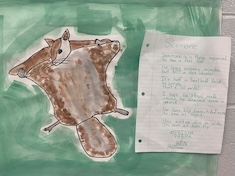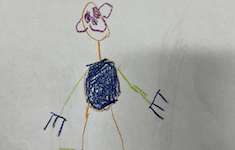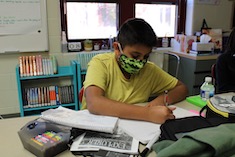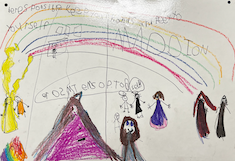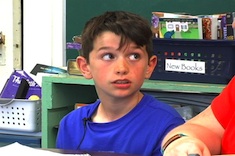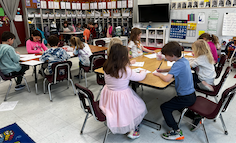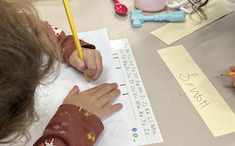Teaching Writing
Everyone who writes for Choice Literacy loves teaching writing, because we all write ourselves. We know it is "hard fun," as Donald Murray famously said—exasperating and exhilarating at the same time. The writing workshops you will read about here and see in our videos are busy, noisy, vibrant places. And most days, we wouldn't want to be anywhere else than in the midst of 'em! Here is where you'll find our latest discoveries, insights, and occasional boneheaded mistakes in teaching writing.
Latest Content
Purposeful Ways to Incorporate Interactive Writing at the Start of the Year
One of the instructional methods we love the most in primary classrooms is interactive writing. It allows us to target the needs of our learners as individuals and reinforce the phonics rules we’ve been studying whole-class, builds community by co-creating something together, and gives us a chance to use our learning in real, authentic, and purposeful ways. Tara Barnett and Kate Mills offer simple ways you can use interactive writing to co-create your classroom space with your students.
Authentic Audiences for Writing in School
Our student writers deserve to have authentic audiences. Tara Barnett and Kate Mills share two opportunities for authentic peer audiences for finished writing pieces in school. Finding space and time for student writing to be seen and heard by their peers in meaningful ways is essential.
Writing in the Wild: Bringing Back Authenticity
Vivian Chen offers big and small ways to make writing instruction more authentic and engaging for your students.
Wheels: Adapting to Change on the Roller Derby Track and in Your Teaching Life
Gwen Blumberg is inspired by a challenging roller derby practice and sees parallels for teachers who are facing challenging situations with changes to literacy curriculums. If something is shifting in your life, this article is sure to offer you confidence in moving forward.
All the Writing Things: Putting Writers in Charge of Their Writing
Inspired by coding time, Suzy Kaback works with her students to develop an All the Writer Things tool to help writers reflect on their work as writers and become stronger and more efficient.
Not Your Granny’s Grammar: Grammar Manipulatives
Grammar manipulatives create a helpful scaffold to allow students a chance to play and practice, leading to a greater likelihood of transferring skills to their writing. Patty McGee shares a few ideas for grammar manipulatives.
Not Your Granny’s Grammar: So Long, Grammar of Yore
Patty McGee positions us to consider a fresh approach to grammar instruction in this first installment of a three-part series.
Feedback Writers Will Use
Vivian Chen offers insights into the conditions needed to help writers value feedback. She discusses written and verbal feedback, as well as AI-generated feedback.
Shared Writing with Older Readers and Writers
Mandy Robek explored using shared writing experiences in her third-grade classroom and discovered it offered many rich literacy learning opportunities.
Now What? We Went on a Field Trip
Mandy Robek thoughtfully connects a field trip to multiple literacy experiences in her second-grade classroom. If you’re looking to leverage the field trip experience for reading and writing, you’ll love Mandy’s process.
Unleashing Writers
Mandy Robek chronicles the way choice and independence allowed students to have more energy and joy while writing.
Reframing Writers
Julie Johnson encourages educators to take a more in-depth view when assessing student writers. Checklists don’t necessarily grow writers, but focusing on what students are doing well and nudging them forward will.
I Don’t Hate Graphic Organizers
Vivian Chen challenges us to replace an overly prescriptive handout that dictates the contents of a paragraph or essay with more open-ended organizers and exemplars to help students plan and write with more independence.
Bit by Bit: Lifting the Level of Storytelling
Melissa Quimby shifts the way she helps students approach narrative writing by focusing on the conflict and encouraging students to unfold it bit by bit. This small shift lifts the level of the stories students write—you can try it, too!
A Poetic Beginning
Tara Barnett and Kate Mills use poetry to help students discover writing ideas. Inspired by three poems, students share their notebook entries and poems from the first days of a new school year.
Kindergarten Celebration of Writing
Molly James encourages us to consider ways to make a writing celebration meaningful. You’ll be inspired by her kindergarten writing celebration.
Early Writing Opportunities in the Library
Gigi McAllister shares informal writing opportunities for students in the school library. Informal and engaging writing activities where students have lots of choice and encouragement make them feel empowered as writers, help them generalize the writing skills they are learning in the classroom, and create joyful writing experiences.
Building Bridges (and Confidence): Planning Solid Essays
Melissa Quimby offers time and intentional planning to build students’ confidence and capacity as essay writers.
Bet You Didn’t Know: Chicken Eggs and Research
Mandy Robek encourages young writers to collect information about a topic. She provides whole-class and individual structures for students to learn that their understanding can change, as well as to be able to access information when they are ready to draft. Don’t miss Mrs. Robek’s digital class book.
Color Coding: An Organizational Strategy
Leigh Anne Eck gives advice to her middle school writers for collecting research notes.
Plagued by Plagiarism
Plagiarism is an age-old issue, but with the emergence of AI tools, it’s plaguing our classrooms again. Vivian Chen offers three practical (and essential) approaches when working with writers.
Using Self-Portraits as an Assessment Tool for Early Writers
Becca Burk guides us in using self-portraits as an assessment tool for early writers. Becca shares a rubric, self-portrait samples, and practical next steps for her kindergarten writers.
The Art of Noticing: Have Your Students Played with Language Today?
Stella Villalba noticed her students were so busy writing quickly, they were not paying attention to crafting language. A student, Gabriela, turns to a book and asks for help to make her writing sound like the book. Stella uses this moment to slow down the class and create space to be inspired to write in beautiful ways.
Author Moves: More Than “Lots of Detail”
Julie Cox deconstructs craft moves—literally and figuratively—with her high school writers. If you are looking to move conversations about craft beyond “The author used a lot of good details,” then you’ll want to try Julie’s suggestions.
Writing Will Help
Becca Burk’s kindergartners had a tough recess. As they were discussing what they could do differently, one student proclaimed, “Mrs. Burk, writing, writing will help!” Becca shares what unfolded as students made a plan and created signage to post around the playground as reminders for self-control.
Practical Advice for Dealing with Messy Handwriting
Do struggles with handwriting matter? They do when a student can’t even decipher his own words. Katherine Sokolowski confers with fifth grader Sauvi to help him find solutions to the problem.
How Long Does This Have to Be?
Students often question how long a piece of writing needs to be. Gretchen Schroeder shares a strategy that changed the focus of writing projects from length to meaning.
Everyone Wants to Write?
Becca Burk reflects on creating a classroom where everyone wants to write. She offers timely advice for creating a community of writers.
Developing Independent Writers
Vivian Chen tackles the difficult topic of helping students become independent as writers. She offers tips for before, during, and after writing time to uplift student agency.
Encouraging Agency
Melanie Meehan shares three tips on helping students be independent and productive writers. She also includes a hefty list of craft moves from mentor texts to use while teaching writers.
Browse Content By
Type
Category
- Assessment Tools
- Big Fresh Archives
- Booklists
- Choice Numeracy
- Classroom Design
- Common Core
- Community Building
- Conferring
- Content Literacy
- Digital Literacy
- English Language Learners
- Equity
- Family Relations
- Free Samples
- Guiding Groups
- Leadership
- Literacy Coaches
- Mentor Texts
- Minilessons
- New Teacher Mentors
- Podcasts
- Poetry
- Quote Collections
- Reading Strategies
- Self Care
- Struggling and Striving Learners
- Talking and Listening
- Teacher Study Groups
- Teaching Reading
- Teaching Writing
- Word Study and Vocabulary
Author
- Melissa Quimby
- Nawal Qarooni
- Gwen Blumberg
- Julie Cox
- The Lead Learners
- Hannah Tills
- Josie Stewart
- Ruth Metcalfe
- Mallory Messenger
- Becca Burk
- Jodie Bailey
- Vivian Chen
- Mary Brower
- Tiffany Abbott Fuller
- Stephanie Affinito
- Ruth Ayres
- Leigh Anne Eck
- Heather Fisher
- Shari Frost
- Julie Johnson
- Suzy Kaback
- Gigi McAllister
- Shirl McPhillips
- Melanie Meehan
- Cathy Mere
- Debbie Miller
- Tara Barnett and Kate Mills
- Tammy Mulligan
- Dana Murphy
- Bitsy Parks
- David Pittman
- Brenda Power
- Heather Rader
- Matt Renwick
- Mandy Robek
- Christy Rush-Levine
- Gretchen Schroeder
- Jen Schwanke
- Brian Sepe
- Katherine Sokolowski
- Stella Villalba
- Jennifer Vincent
Grade Level
Choice Literacy Membership
Articles
Get full access to all Choice Literacy article content
Videos
Get full access to all Choice Literacy video content
Courses
Access Choice Literacy course curriculum and training









